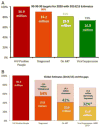Quality of tuberculosis care in high burden countries: the urgent need to address gaps in the care cascade
- PMID: 27794468
- PMCID: PMC5346036
- DOI: 10.1016/j.ijid.2016.10.016
Quality of tuberculosis care in high burden countries: the urgent need to address gaps in the care cascade
Abstract
Despite the high coverage of directly observed treatment short-course (DOTS), tuberculosis (TB) continues to affect 10.4 million people each year, and kills 1.8 million. High TB mortality, the large number of missing TB cases, the emergence of severe forms of drug resistance, and the slow decline in TB incidence indicate that merely expanding the coverage of TB services is insufficient to end the epidemic. In the era of the End TB Strategy, we need to think beyond coverage and start focusing on the quality of TB care that is routinely offered to patients in high burden countries, in both public and private sectors. In this review, current evidence on the quality of TB care in high burden countries, major gaps in the quality of care, and some novel efforts to measure and improve the quality of care are described. Based on systematic reviews on the quality of TB care or surrogates of quality (e.g., TB diagnostic delays), analyses of TB care cascades, and newer studies that directly measure quality of care, it is shown that the quality of care in both the public and private sector falls short of international standards and urgently needs improvement. National TB programs will therefore need to systematically measure and improve quality of TB care and invest in quality improvement programs.
Keywords: Cascade of care; Quality improvement; Quality of care; Standards for TB care; Tuberculosis.
Copyright © 2016 The Author(s). Published by Elsevier Ltd.. All rights reserved.
Conflict of interest statement
None of the authors have financial or industry conflicts to disclose. MP serves as a consultant to the Bill & Melinda Gates Foundation, and on advisory committees of FIND, Geneva, and TB Alliance, New York. These agencies had no involvement in this manuscript.
Figures




References
-
- Uplekar M, Weil D, Lonnroth K, et al. WHO’s new End TB Strategy. Lancet. 2015;385(9979):1799–801. - PubMed
-
- World Health Organization. Global Tuberculosis Report 2016. Geneva: WHO; 2016.
-
- Scott KW, Jha AK. Putting quality on the global health agenda. The New England journal of medicine. 2014;371(1):3–5. - PubMed
-
- Kruk ME, Larson E, Twum-Danso NA. Time for a quality revolution in global health. The Lancet Global health. 2016;4(9):e594–6. - PubMed
Publication types
MeSH terms
Grants and funding
LinkOut - more resources
Full Text Sources
Other Literature Sources
Medical

